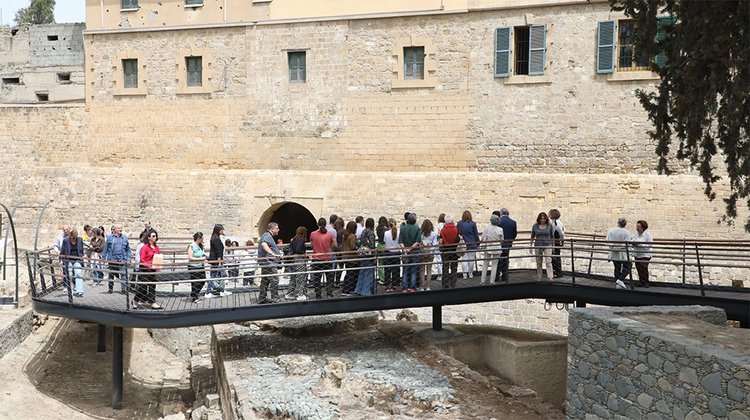STARC’s Virtual Environments and APAC Labs contribute to Pafos Gate conservation (pics)
07:17 - 27 April 2024

Following excavations, the archaeological site of Pafos Gate, one of the three medieval gates of Nicosia, has been inaugurated by Deputy Minister of Culture Dr. Vasiliki Kassianidou and Mayor of Nicosia Constantinos Yiorkadjis.

The Monday 22 April inauguration took place in the presence of the Director of the Department of Antiquities Dr Giorgos Georgiou, Director of the Department of Public Works Eleftherios Eleftheriou, Director of CyI’s STARC Dr Michel Menu, and former Directors of the Department of Antiquities, Dr Marina Solomidou-Ieronymidou and Dr. Sophocles Hadjisavvas.
Speaking at the event, Deputy Minister of Culture Dr. Vasiliki Kassianidou said that due to the importance of the findings unearthed in the area, the Department of Antiquities in collaboration with the Cyprus Institute team conducted a study with the aim of “highlighting the site as an experiential museum of Nicosia’s history”. Deputy Minister Kassianidou pointed out that this was “not an easy task”, but that the Department of Antiquities and The Cyprus Institute managed to “achieve a very successful result”. She added that the project’s success is “proof that cooperation between local authorities, the competent departments, and Cyprus’ research institutions can lead to the best possible result for the preservation and promotion of its monuments”.

The STARC team from the Virtual Environments Lab and APAC Labs, led by Assoc. Professor Georgios Artopoulos, have been collaborating on this innovative project with the Department of Antiquities, since excavation of the site started back in 2014. According to the most current approaches to the management of historic sites in urban environments, unhindered access for all to the excavation, its findings, and its history, can provide functional and social benefits to the neighborhood.

As noted in a press release on the inauguration, Paphos Gate presents a very rich historical palimpsest of Nicosia's architectural fabric, with examples from almost all periods of the city's history. Respecting this unique character, a walk through the archaeological site was created by means of an innovative, interdisciplinary process of inclusive co-design.

This process engaged experts from the fields of architecture, urban planning, history, and archaeology, as well as the competent officials of the relevant bodies (Nicosia Municipality and Department of Antiquities), as well as citizens of Nicosia, and invited them to offer their ideas and opinions on the management plan of the site by means of co-designing a walking platform in a virtual environment. Through this awarded innovative method, participants had the opportunity to virtually visit different historical periods of the Paphos Gate, as if they had a time machine that allowed them to explore this important area of Nicosia and its transformation in time.

Credits: Georgios Artopoulos, Nikolas Bakirtzis, Nicolas Loucas, Charalambos Ioannou, Panayiotis Charalambous, Harry Varnava and Marina Faka (STARC); Dr Marina Solomidou-Ieronymidou and Polina Christofi (Cyprus Department of Antiquities); Agni Petridou and Athina Papadopoulou (Nicosia Municipality); Donna J Cox, Kenton Guadron McHenry, AJ Christensen, Colter Wehmeier, and Kajetan Haas (University of Illinois, Urbana-Champaign, National Center for Supercomputing Applications, AVL).
